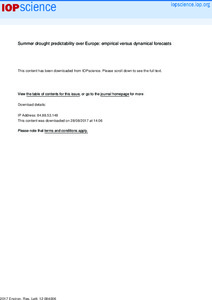Mostra el registre d'ítem simple
Summer drought predictability over Europe: empirical versus dynamical forecasts
| dc.contributor.author | Turco, Marco |
| dc.contributor.author | Ceglar, Andrej |
| dc.contributor.author | Prodhomme, Chloé |
| dc.contributor.author | Soret, Albert |
| dc.contributor.author | Toreti, Andrea |
| dc.contributor.author | Doblas-Reyes, Francisco |
| dc.contributor.other | Barcelona Supercomputing Center |
| dc.date.accessioned | 2017-08-28T13:23:57Z |
| dc.date.available | 2017-08-28T13:23:57Z |
| dc.date.issued | 2017-07-27 |
| dc.identifier.citation | Turco, M. [et al.]. Summer drought predictability over Europe: empirical versus dynamical forecasts. "Environmental Research Letters", 27 Juliol 2017, vol. 12, núm. 8. |
| dc.identifier.issn | 1748-9326 |
| dc.identifier.uri | http://hdl.handle.net/2117/107194 |
| dc.description.abstract | Seasonal climate forecasts could be an important planning tool for farmers, government and insurance companies that can lead to better and timely management of seasonal climate risks. However, climate seasonal forecasts are often under-used, because potential users are not well aware of the capabilities and limitations of these products. This study aims at assessing the merits and caveats of a statistical empirical method, the ensemble streamflow prediction system (ESP, an ensemble based on reordering historical data) and an operational dynamical forecast system, the European Centre for Medium-Range Weather Forecasts—System 4 (S4) in predicting summer drought in Europe. Droughts are defined using the Standardized Precipitation Evapotranspiration Index for the month of August integrated over 6 months. Both systems show useful and mostly comparable deterministic skill. We argue that this source of predictability is mostly attributable to the observed initial conditions. S4 shows only higher skill in terms of ability to probabilistically identify drought occurrence. Thus, currently, both approaches provide useful information and ESP represents a computationally fast alternative to dynamical prediction applications for drought prediction. |
| dc.description.sponsorship | We acknowledge the NOAA/OAR/ESRL PSD, Boulder, Colorado, USA, for making the data available on their website http://www.esrl.noaa.gov/psd/. This work was partially funded by the Projects IMPREX (EU–H2020 PE024400) and SPECS (FP7-ENV-2012-308378). Marco Turco was supported by the Spanish Juan de la Cierva Programme (IJCI-2015-26953). |
| dc.format.extent | 10 p. |
| dc.language.iso | eng |
| dc.publisher | IOP Publishing |
| dc.rights | Attribution-NonCommercial-NoDerivs 3.0 Spain |
| dc.rights.uri | http://creativecommons.org/licenses/by-nc-nd/3.0/es/ |
| dc.subject | Àrees temàtiques de la UPC::Energies |
| dc.subject.lcsh | Weather forecasting |
| dc.subject.lcsh | Seasonal climate forecasting |
| dc.subject.other | Drought |
| dc.subject.other | Seasonal forectast |
| dc.subject.other | Standardized precipitation evapotranspiration index (SPEI) |
| dc.title | Summer drought predictability over Europe: empirical versus dynamical forecasts |
| dc.type | Article |
| dc.subject.lemac | Previsió del temps |
| dc.subject.lemac | Climatologia |
| dc.identifier.doi | 10.1088/1748-9326/aa7859 |
| dc.description.peerreviewed | Peer Reviewed |
| dc.relation.publisherversion | http://iopscience.iop.org/article/10.1088/1748-9326/aa7859 |
| dc.rights.access | Open Access |
| dc.description.version | Postprint (published version) |
| dc.relation.projectid | info:eu-repo/grantAgreement/EC/H2020/641811/EU/IMproving PRedictions and management of hydrological EXtremes/IMPREX |
| dc.relation.projectid | info:eu-repo/grantAgreement/EC/FP7/308378/EU/Seasonal-to-decadal climate Prediction for the improvement of European Climate Services/SPECS |
| dc.relation.projectid | info:eu-repo/grantAgreement/MINECO//IJCI-2015-26953/ES/IJCI-2015-26953/ |
| local.citation.publicationName | Environmental Research Letters |
| local.citation.volume | 12 |
| local.citation.number | 8 |
Fitxers d'aquest items
Aquest ítem apareix a les col·leccions següents
-
Articles de revista [390]


